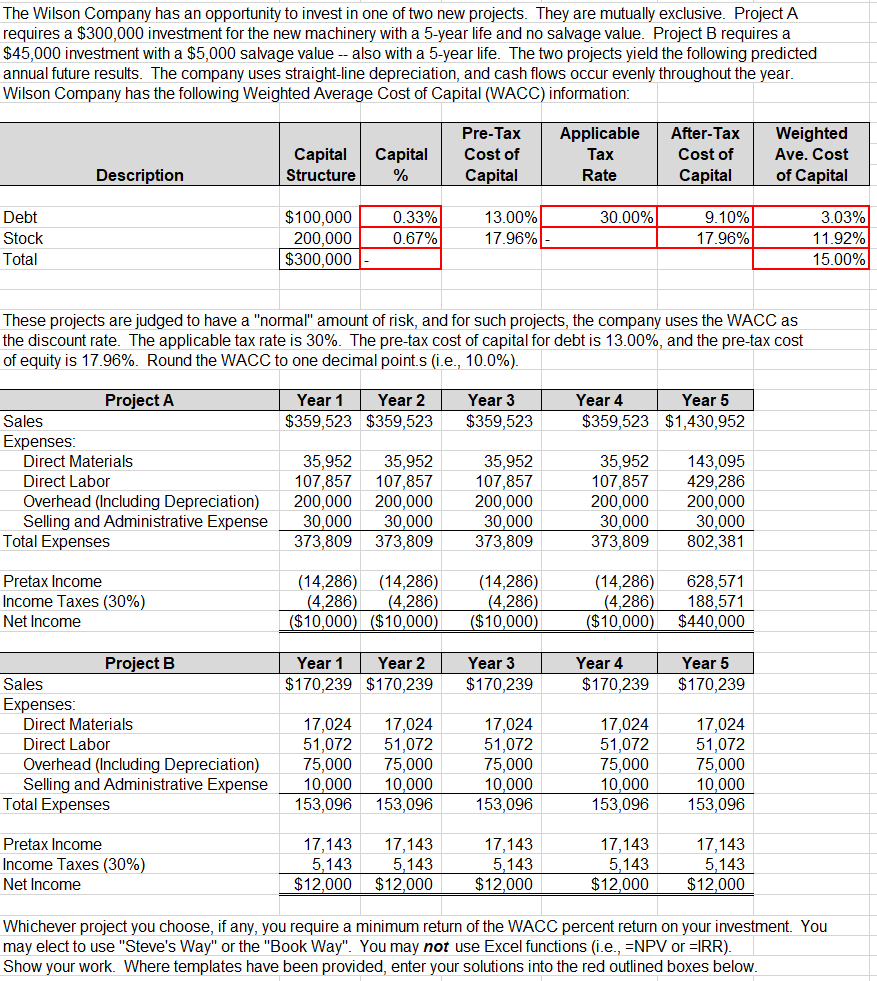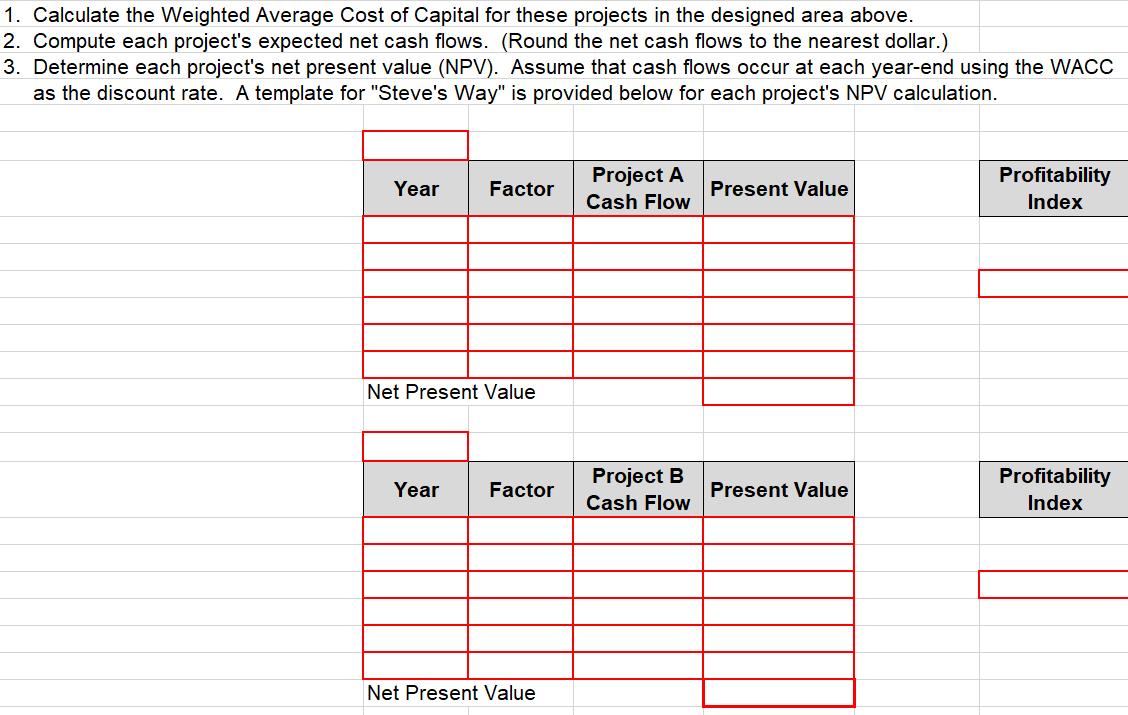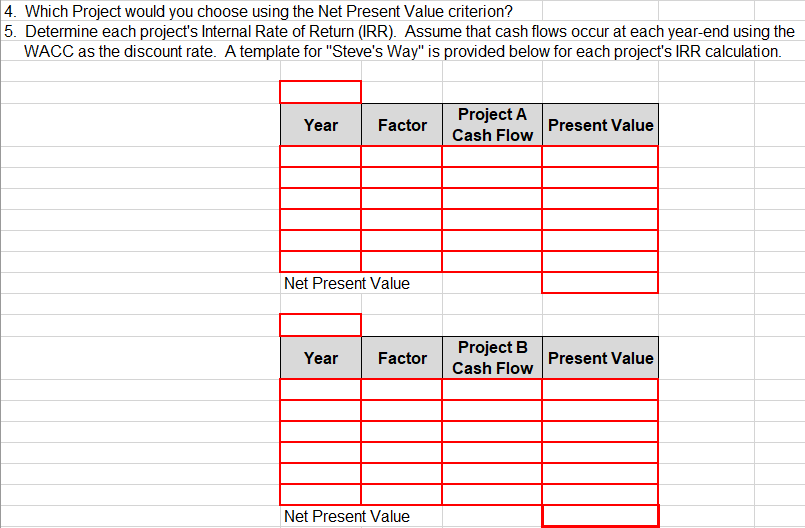



The Wilson Company has an opportunity to invest in one of two new projects. They are mutually exclusive. Project A requires a $300,000 investment for the new machinery with a 5-year life and no salvage value. Project B requires a $45,000 investment with a $5,000 salvage value -- also with a 5-year life. The two projects yield the following predicted annual future results. The company uses straight-line depreciation, and cash flows occur evenly throughout the year. Wilson Company has the following Weighted Average Cost of Capital (WACC) information: Capital Structure Capital % Pre-Tax Cost of Capital Applicable Tax Rate After-Tax Cost of Capital Weighted Ave. Cost of Capital Description 30.00% Debt Stock Total $100,000 200,000 $300,000 0.33% 0.67% 13.00% 17.96% 9.10% 17.96% 3.03% 11.92% 15.00% These projects are judged to have a "normal" amount of risk, and for such projects, the company uses the WACC as the discount rate. The applicable tax rate is 30%. The pre-tax cost of capital for debt is 13.00%, and the pre-tax cost of equity is 17.96%. Round the WACC to one decimal points (i.e., 10.0%). Year 1 Year 2 $359,523 $359,523 Year 3 $359,523 Year 4 Year 5 $359,523 $1,430,952 Project A Sales Expenses Direct Materials Direct Labor Overhead (Including Depreciation) Selling and Administrative Expense Total Expenses 35,952 35,952 107,857 107,857 200,000 200,000 30,000 30,000 373,809 373,809 35,952 107,857 200,000 30,000 373,809 35,952 107,857 200,000 30,000 373,809 143,095 429,286 200,000 30,000 802,381 Pretax Income Income Taxes (30%) Net Income (14,286) (14,286) (4,286) (4,286) ($10,000) ($10,000) (14,286) (4,286) ($10,000) (14,286) (4,286) ($10,000 628,571 188,571 $440,000 Year 1 Year 2 $170,239 $170,239 Year 3 $170,239 Year 4 $170,239 Year 5 $170,239 Project B Sales Expenses Direct Materials Direct Labor Overhead (Including Depreciation) Selling and Administrative Expense Total Expenses 17,024 51,072 75,000 10,000 153,096 17,024 51,072 75,000 10,000 153,096 17,024 51,072 75,000 10,000 153,096 17,024 51,072 75,000 10,000 153,096 17,024 51,072 75,000 10,000 153,096 Pretax Income Income Taxes (30%) Net Income 17,143 5.143 $12,000 17,143 5.143 $12,000 17,143 5,143 $12,000 17,143 5,143 $12,000 17,143 5,143 $12,000 Whichever project you choose, if any, you require a minimum return of the WACC percent return on your investment. You may elect to use "Steve's Way" or the "Book Way". You may not use Excel functions (i.e., ENPV or EIRR). Show your work. Where templates have been provided, enter your solutions into the red outlined boxes below. 1. Calculate the Weighted Average Cost of Capital for these projects in the designed area above. 2. Compute each project's expected net cash flows. (Round the net cash flows to the nearest dollar.) 3. Determine each project's net present value (NPV). Assume that cash flows occur at each year-end using the WACC as the discount rate. A template for "Steve's Way" is provided below for each project's NPV calculation. Year Factor Project A Cash Flow Present Value Profitability Index Net Present Value Year Factor Project B Cash Flow Present Value Profitability Index Net Present Value 4. Which Project would you choose using the Net Present Value criterion? 5. Determine each project's Internal Rate of Return (IRR). Assume that cash flows occur at each year-end using the WACC as the discount rate. A template for "Steve's Way" is provided below for each project's IRR calculation. Year Factor Project A Cash Flow Present Value Net Present Value Year Factor Project B Cash Flow Present Value Net Present Value 6. Which Project would you choose using the Internal Rate of Return criterion? 7. Which Project would you choose considering both the NPV and the IRR criterion? 8. Determine each project's (simple) payback period. (Round the payback period to two decimals.) A template has been provided below for calculating the (simple) payback period. Year Factor Project A Cash Flow Present Value Cumulative Cash Flow Payback Net Present Value Year Factor Project B Cash Flow Cumulative Present Value Cash Flow Payback Net Present Value










